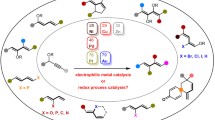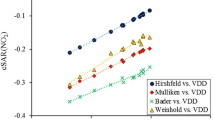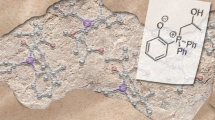Abstract
The reaction mechanism between propadienylidene and ethylene has been systematically investigated employing the B3LYP/6-311++G** and MP2/cc-pVTZ levels of theory to better understand the reactivity of propadienylidene with unsaturated hydrocarbons. Geometry optimization, vibrational analysis, and energy property for the involved stationary points on the potential energy surface have been calculated. Two important initial reaction complexes characterized by three- and four-membered ring structures have been located firstly. After that, three different products possessing three-, four-, and five-membered ring characters have been obtained through three reaction pathways. In the first reaction pathway, a three-membered ring alkyne compound has been obtained. As for the second reaction pathway, it is a diffusion-controlled reaction, resulting in the formation of the four-membered ring conjugated diene compound. A five-membered conjugated diene compound has been obtained in the third reaction pathway, which is the most stable product in the available products thermodynamically. On the other hand, the second reaction pathway is the most favorable reaction to proceed kinetically.









Similar content being viewed by others
References
Mitani M, Kobanashi Y, Koyama K (1995) J Chem Soc Perkin Trans I:653
Garcia M, Campo CD, Llama EF (1993) Tetrahedron Lett 49:8433
Garcia M, Campo CD, Llama EF (1995) J Chem Soc Perkin Trans I:1771
Kostikov RR, Khlebnikov AF, Bespalov VY (1993) J Phys Org Chem 6:83
Wang Y, Li H (2004) Acta Phys-Chim Sin 20:1339
Stang PJ (1982) J Am Chem Res 15:348
Lu XH, Wang YX (2003) J Phys Chem A 107:7885
Lu XH, Wang YX (2004) J Mole Struct (THEOCHEM) 686:207
Apeloig Y, Karni M, Stang PJ (1983) J Am Chem Soc 105:4781
Fox DP, Stang PJ, Apeloig Y, Karni M (1986) J Am Chem Soc 108:750
Tan XJ, Li P, Wang WH, Zheng GX, Yang XL (2009) Struct Chem 20:671
Tan XJ, Li P, Wang WH, Zheng GX, Wang QF (2010) J Serb Chem Soc 75:649
Herges R, Mebel A (1994) J Am Chem Soc 116:8229
Maier G, Reisenauer HP, Schwab W, Carsky P, Hess BA, Schaad LJ (1987) J Am Chem Soc 109:5183
Seburg RA, DePinto JT, Patterson EV, McMahon RJ (1995) J Am Chem Soc 117:835
MacAllister T, Nicholson A (1981) J Chem Soc Faraday Trans 77:821
Seburg RA, MacMahon R (1995) Angew Chem Int Ed Engl 34:2009
Seburg RA, Patterson EV, Stanton JF, McMahon RJ (1997) J Am Chem Soc 119:5847
Maier G, Reisenauer HP, Schwab W, Carsky P, Spirko V, Hess BA, Schaad LJ (1989) J Chem Phys 91:4763
Juana V, Michael EH, Jurgen G, John FS (2009) J Phys Chem A 113:12447
Taatjes CA, Klippenstein SJ, Hansen N, Miller JA, Cool TA, Wang J, Law ME, Westmoreland PR (2005) Phys Chem Chem Phys 7:806
Lau KC, Ng CY (2006) Chin J Chem Phys 19:29
Gleiter R, Hoffmann R (1968) J Am Chem Soc 90:5457
Shepard R, Banerjee A, Simons J (1979) J Am Chem Soc 101:6174
Lee TJ, Bunge A, Schaefer HF (1985) J Am Chem Soc 107:137
Montgomery JA, Ochterski JW, Petersson GA (1994) J Chem Phys 101:5900
Hehre WJ, Pople JA, Lathan WA, Radom L, Wasserman E, Wasserman ZR (1976) J Am Chem Soc 98:4378
Jonas V, Bohme M, Frenking G (1992) J Phys Chem 96:1640
Takahashi J, Yamashita K (1996) J Chem Phys 104:6613
Fan Q, Pfeiffer GV (1989) Chem Phys Lett 162:472
Walch SP (1995) J Chem Phys 103:7064
Kirmse W (1971) Carbene chemistry, 2nd edn. Academic Press, New York
Jones M, Moss RA (1973) Carbenes. Wiley, New York
Herbst E (1990) Angew Chem Int Ed Engl 29:595
Herbst E, Leung LM (1989) Astrophys J Suppl Ser 69:271
Winnewisser G (1981) Top Curr Chem 99:39
Hayatsu R, Anders E (1981) Top Curr Chem 99:1
Thaddeus P, Gottlieb CA, Mollaaghababa R, Vrtilek JM (1993) J Chem Soc Faraday Trans 89:2125
Fabien G, Adam JT, Giovanni M, Talitha MS, David LO, Craig AT, Luc V, Stephen RL (2009) J Am Chem Soc 131:993
Parr RG, Yang W (1989) Density-functional theory of atoms and molecules. Oxford University Press, Oxford
Frisch MJ, Trucks GW, Schlegel HB, Scuseria GE, Robb MA, Cheeseman JR, Zakrzewski VG, Montgomery JA, Stratmann RE, Burant JC, Dapprich S, Millam JM, Daniels AD, Kudin KN, Strain MC, Farkas O, Tomasi J, Barone V, Cossi M, Cammi R, Mennucci B, Pomelli C, Adamo C, Clifford S, Ochterski J, Petersson GA, Ayala PY, Cui Q, Morokuma K, Malick DK, Rabuck AD, Raghavachari K, Foresman JB, Cioslowski J, Ortiz JV, Stefanov BB, Liu G, Liashenko A, Piskorz P, Komaromi I, Gomperts R, Martin RL, Fox DJ, Keith T, Al-Laham MA, Peng CY, Nanayakkara A, Gonzalez C, Challacombe M, Gill PM, Johnson BG, Chen W, Wong MW, Andres JL, Head-Gordon M, Replogle ES, Pople JA(1998) Gaussian 98, revision A.9. Gaussian, Inc., Pittsburgh, PA
Acknowledgment
This work is supported by NSFC (21003082, 31070046), the Project of Shandong Province Higher Educational Science and Technology Program (J09LB01, J09LB17), and the Foundation for Outstanding Young Scientist in Shandong Province (BS2009HZ014, BS2010NJ009). We are also grateful to the reviewers for their insightful suggestions to improve the presentation of the results.
Author information
Authors and Affiliations
Corresponding authors
Rights and permissions
About this article
Cite this article
Tan, X., Li, P., Wang, W. et al. Insights into the reaction mechanism between propadienylidene and ethylene: a DFT study. Struct Chem 22, 1031–1037 (2011). https://doi.org/10.1007/s11224-011-9798-8
Received:
Accepted:
Published:
Issue Date:
DOI: https://doi.org/10.1007/s11224-011-9798-8




